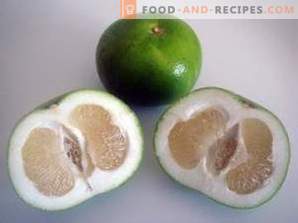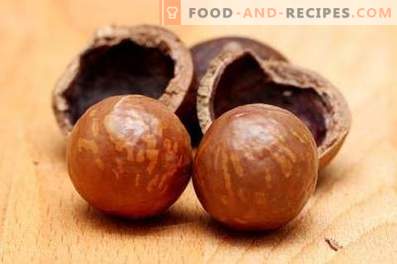
Grapefruit is a fruit of the genus of the Rut family citrus. Grapefruit fruits are usually collected in grape-like clusters. This feature gave the name of the plant: grape in English means grapes, and fruit - fruit. Until about the 30s of the XIX century, the grapefruit tree was taken for a relative broom, and only after some time the fruit got its own name in Latin: Citrus paradisi. Grapefruit in its origin is a random (natural) hybrid of orange and pomelo. For the first time, the fruit was described by the Welsh priest Griffiths Hughes, keen on botany, in 1750. The discoverer gave the grapefruit the name “forbidden fruit”. Somewhat earlier, in the 17th century, the English navigator Sheddock brought a broom on Fr. Barbados, and this kind of then became known as “Sheddock”. Therefore, the “forbidden fruit”, which was discovered in the middle of the 18th century, was called the “little sheddok” because of its similarity. 64 years after the discovery, grapefruit received its current name from Jamaican traders.
After the 1870s, the rate of cultivation of the plant increased significantly. After distribution in the US, grapefruit began to grow on the Caribbean coast, near Brazil, in Israel and South Africa. Already in the last century, the plant became one of the leading products on the world fruit market, clearly eclipsed one of the biological parents - pomelo. The taste of grapefruit is less sweet than that of an orange, and this culture is often referred to as dietary products. On the basis of grapefruit, many hybrids were bred, for example, tanzhelo and mineola (the result of crossing with different varieties of mandarins). The grapefruit tree is almost the record among related fruits: its trunk can reach 16 meters in height, although on average this value is 6-7 meters. The leaves are very thin and elongated (up to 16 cm in length), the color is usually dark green. Grapefruit flowers are quite small (about 2-3 cm in radius), painted white and have 4-5 petals. The fruit of the plant is somewhat larger than that of an orange - their diameter is about 11-16 cm, but the internal structure with division into lobes is identical. The sour pulp can be either bright yellow or ruby red — it all depends on the particular variety; in the same way, a strong grapefruit rind is light or reddish. Fruits have time to ripen in 10-12 months, and in the states that cultivate this plant, in the first weeks of February, the “Grapefruit Collection Holiday” is held.
Numerous grapefruit varieties (more than 20 items) are divided into 2 basic categories: yellow (or so-called “white”) and red fruits. As a rule, the sweeter grapefruit pulp corresponds to a dark color. The first variety with Ruby red flesh was bred in the USA in the middle of the last century. Subsequently, several more sweet varieties of culture were produced in Texas from the resulting variety. Grapefruits such as Flame, Star Ruby and Rio Red are the most famous in the world. Different varieties can differ not only in the color of the pulp and taste, but also in the number of seeds.
Not only the use of raw grapefruits is widespread, but also their use in creating fruit and spicy salads. Fruits are great for making juices and jams. Essential oil from grapefruit slices is used for the production of confectionery and alcoholic beverages, as well as in perfumery.
Nutritional value and vitamin content in grapefruit pulp
Grapefruit is a dietary product not only because of the low calorie content of the pulp, but also because of the ability of the fruit to reduce glucose levels and burn extra calories due to the presence of monounsaturated fats. The nutritional value of 100 grams of grapefruit pulp is so impressive that the product is recommended by nutritionists for almost all consumers without exception.
- 0, 71 g of proteins;
- 0, 09 g of fat, including 0, 014 monounsaturated and 0, 023 polyunsaturated;
- 8, 91 g of carbohydrates;
- 40 kilocalories, or 167 kJ;
- 1, 78 g of dietary fiber;
- 1, 48 g of organic acids;
- 90 g of water;
- 6, 7 g of monosaccharides and disaccharides;
- 0, 4 g of ash.
Numerous vitamins (this is especially pronounced for group B vitamins), consisting of 100 grams of grapefruit pulp, can not only protect people from infections, but also serve as a real remedy for the internal systems of the body.
- 049 mg of thiamine (B1);
- 0, 029 mg of riboflavin (B2);
- 0, 028 mg of pantheonic acid (B5);
- 0, 039 mg of pyridoxine (B6);
- 3, 01 μg of folic acid (B9);
- 3, 11 μg of retinol equivalent (A);
- 45, 15 mg of ascorbic acid (C);
- 0, 29 mg alpha-tocopherol (E);
- 0, 021 mg of beta-carotene;
- 0, 28 mg of niacin equivalent (PP).
The content of macronutrients and trace elements in grapefruit
Mineral-rich grapefruit pulp effectively fills the body's need for essential macronutrients. 100 fruits contain:
- 23, 2 mg of calcium (Ca);
- 10, 1 mg of magnesium (Mg);
- 13, 2 mg of sodium (Na);
- 183, 8 mg of potassium (K);
- 17, 7 mg of phosphorus (P).
Among the main microelements in the composition of the pulp of this tropical fruit dominate
- 0, 52 mg of iron (Fe);
- 0, 049 mg of zinc (Zn).
Unique useful properties of grapefruit
- Grapefruit pulp contains a higher concentration of ascorbic acid than orange and even lemon. As you know, vitamin C is essential for protection against viruses and infections, as well as for colds. Only one medium-sized grapefruit provides a daily rate of ascorbic acid for humans.
- Many essential vitamins and minerals in grapefruit help to stabilize the metabolic processes in the body and prevent potential problems. In addition, the fruit is abundant in organic acids, essential oils, mineral salts, and naringin. The said component is in the white bitter partitions of the lobules. It is useful for the gastrointestinal tract and reducing the level of “bad” cholesterol in the blood. The presence of pectin also contributes to these beneficial processes, which together save a person from the risk of atherosclerosis. These substances help with diseases of the heart and blood vessels, and for women also facilitate menopause.
- Nutritional research in San Diego proved an amazing fact: eating grapefruit helps reduce weight. Within four months, two groups ate the same foods, but in the first one each supplemented their meals with half a grapefruit. Upon completion of the experiment, it was found that the participants of the first group, on average, lost two kilograms, while no change in the weight of the second group was found. The phenomenon is explained by the fact that grapefruit reduces insulin and glucose in the blood. This effect allows us to recommend the fruit as a tool for the treatment and prevention of diabetes. Despite the results of the experiment in San Diego, it would be wrong to assume that grapefruit is able to burn fat. Nevertheless, eating grapefruit half an hour before a meal has a very positive response to the digestive processes.
- Grapefruit zest can be grated dried and consumed one spoon per day. This medicine will help get rid of heartburn and discomfort in the stomach. Before swallowing the mixture is best held in the mouth and dissolve. It should also be remembered that the outer side of the rind of store fruits is sometimes treated with chemicals.
- Fiber in the composition of the pulp of grapefruit normalizes the gastrointestinal tract, prevents constipation, removes toxins. The use of this fruit prevents the development of obesity and beriberi.
- Grapefruits are known for the anticancer and bactericidal properties of their ingredients.
- The smell of essential oils and the taste of grapefruit keeps the body in good shape, relieves from overwork and depression. The pulp and juice of grapefruit can not only elevate mood due to the beneficial effects on the nervous system, but also ensure healthy sleep, saving you from insomnia.
- The unique features of grapefruit have become useful not only for the internal systems of the body, but also for the manufacture of various cosmetics.
- In cooking, the above-described sourish fruit is used both to make jam and as a seasoning for meat dishes.
Diseases in which the use of grapefruit is contraindicated
In case of acute forms of certain diseases, it is better not to eat grapefruit or consult with your doctor beforehand. These diseases include:
- allergic reaction to citrus fruits;
- duodenal ulcer and stomach;
- heartburn and belching sour;
- gastritis;
- reflux esophagitis (can only be aggravated by the use of grapefruit, as its taste enhances the release of gastric juice into the esophagus);
- diseases of the bladder and kidneys;
- colitis and enterocolitis;
- problems with the enamel of the teeth (may be aggravated due to the presence of ascorbic, malic, citric and quinic acid in grapefruit).
It is important to closely monitor the use of grapefruit by children, since it is they who most often have allergies.























